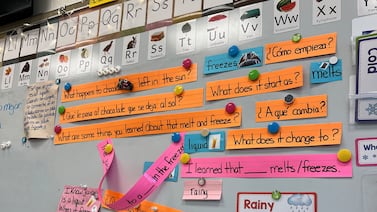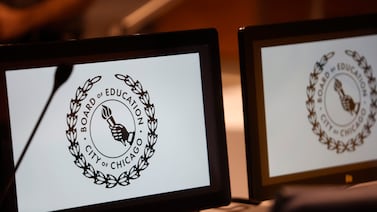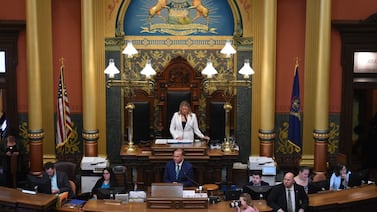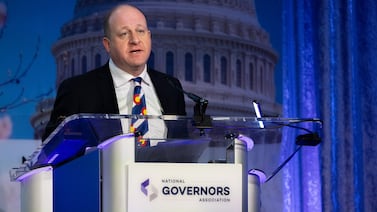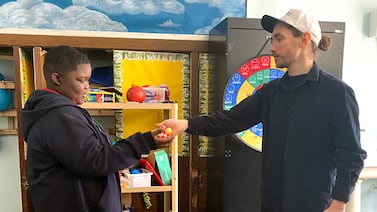Sign up for Chalkbeat Indiana’s free daily newsletter to keep up with Indianapolis Public Schools, Marion County’s township districts, and statewide education news.
Options Schools plans to send a letter to the state legislature in the coming months with an urgent plea: Reinstate funding for alternative schools.
Alternative schools provide education to middle and high school students who might struggle in a traditional school setting. The latest state budget slashes funding for alternative schools from more than $5 million in the last state budget to just $760,000 for 2025-2027 that will go to a specific type of alternative school.
The Indiana Department of Education identifies potential alternative school students as those who are parents, intend to withdraw from high school before graduation, work to support their families, or are disruptive in their current school. Alternative schools are often these students’ last chance to get their diploma. They are usually more expensive to run than traditional schools because of low teacher-student ratios and their more specialized curriculum.
Typically, alternative schools receive money in addition to the state’s per-student funding to account for the extra cost of these programs. The new state budget provides only enough money for schools dedicated to educating students in recovery from or struggling with substance abuse. Recovery schools will receive $10,000 per student.
Most of the alternative schools in the state are not accredited recovery schools. Indiana has only one, Hope Academy in Indianapolis, which had 55 students last year. The budget leaves the other 200-plus Indiana alternative schools with a funding gap.
Alternative schools offer flexibility, support
Options Schools CEO Mike Gustin credits the charter network’s success – it has schools across the state – to its focus on what he calls “acclimatization” — addressing challenges that might keep kids out of school. Options offers programming such as art therapy, social-emotional counselors, and a food and clothing pantry.
“If we properly acclimate a student, they’re more likely to attend at a higher rate. Higher attendance means higher credit attainment, high credit attainment means more kids get back on track for graduation,” he said. “But all that talk takes money.”
Typically, Options schools receive more than $500,000 in alternative school funding from the state. It’s adapting to the loss by cutting programs that don’t have a good return on investment, implementing smaller staff salary raises than usual, and making other cuts. As they lose more funds, Gustin worries that more significant programming will be impacted.
Other schools with fewer students took a smaller, but still significant, hit.
Dynamic Minds Academy is an alternative school serving kids with autism that personalizes its curriculum. This summer, Dynamic Minds has 14 graduating students, none of whom finished in four years.
“They needed that extra time that the alternative school programming allows for,” said Dynamic Minds Education Director Samantha Bandy.
Last year, Dynamic Minds received $50,000 in alternative school funding. The loss of funds has led to a hiring freeze, which will affect the school’s ability to maintain a low student-teacher ratio.
“These students, in addition to their academic needs, may have behavioral needs,” said Bandy. “We’re a lot of times their last opportunity to get a diploma, so restricting the kind of funding that we can receive for that programming is a disservice.”
She worries that there will be fewer alternative school programs in Indiana if funding is not restored.
“So you could see a lot more students missing out on opportunities to graduate because districts aren’t going to take the risk to start a program like this,” she said.
Cuts due to $2 billion decrease in state revenue
The cuts can largely be attributed to a grim forecast that predicted the state would have $2 billion less in revenue in the 2026-2027 budget cycle. To meet this moment, state lawmakers looked everywhere they could, trying to find $2 billion in the previous year’s budget that could be cut. Alternative education ended up on the chopping block.
Despite the loss in funds, Gustin remains optimistic. He said that lawmakers, including the Speaker of the House Todd Huston, seemed open to listening to alternative education advocates. He hopes lawmakers will give them consideration if the opportunity comes to re-evaluate the budget.
“They’re terrific supporters, they are always amenable to opening their door and having conversations with us, so that’s where the hope comes from,” he said.
Gustin has written a letter to the legislature that he hopes leaders of the over 200 alternative schools in the state will sign.
A budget re-evaluation would only occur if the state performs better than the forecast predicted, or it receives extra money from the federal government. Most likely, alternative education funding will next be considered in 2027, during deliberation over the new biennium’s budget.
Samantha Camire is a summer reporting intern covering education in the Indianapolis area. Contact Samantha at scamire@chalkbeat.org.


